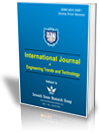A Study on the Comparison of Characteristics of Three Types of Whistle Sounds
A Study on the Comparison of Characteristics of Three Types of Whistle Sounds |
||
 |
 |
|
| © 2025 by IJETT Journal | ||
| Volume-73 Issue-3 |
||
| Year of Publication : 2025 | ||
| Author : Ik-Soo Ahn |
||
| DOI : 10.14445/22315381/IJETT-V73I3P142 | ||
How to Cite?
Ik-Soo Ahn, "A Study on the Comparison of Characteristics of Three Types of Whistle Sounds," International Journal of Engineering Trends and Technology, vol. 73, no. 3, pp. 590-598, 2025. Crossref, https://doi.org/10.14445/22315381/IJETT-V73I3P142
Abstract
A whistle is a type of tool that produces sound by blowing among various signaling tools. The whistle has evolved structurally to produce sharp and strong sounds, and due to its characteristics, it is effectively used in fields where clear intentions are expressed. The main fields where whistles are used are as referees in sports games, when the police control the surroundings, and when individuals are notified of danger. In addition, whistles used in each field are classified into unique whistles with individual characteristics according to their purpose. This paper is a study to verify whether representative whistles used according to their purpose in the three fields presented above are effectively utilizing the sound characteristics appropriate for the situation. For the study, the sounds of the three representative whistles were compared and analyzed. As a research method, the sound characteristics of the three whistles were scientifically analyzed, and the listeners' responses were investigated and compared. As a result, a referee whistle in sports games, a police whistle, and a self-defense whistle showed strong sound signals and unique tones in that order. In addition, the sounds of the three whistles have been learned through experience by the general public, so they can be easily distinguished by field and verified to be used appropriately for the situation.
Keywords
Whistle, A referee whistle, A police whistle, A self-defense whistle, Sound characteristics, Experience, Verify.
References
[1] Roberto Velazquez, and Francisco Rivas Castro, “Death Whistle,” The Journal of the Acoustical Society of America, vol. 128, no. 4, 2010.
[CrossRef] [Google Scholar] [Publisher Link]
[2] Eva M. Dadlez, “Pleased and Afflicted: Human on the Paradox Tragic Pleasure,” Hume Studies, vol. 30, no. 2, pp.213-236, 2004.
[Google Scholar] [Publisher Link]
[3] Seong-Geon Bae, Myung-Sook Kim, and Myung-Jin Bae, “Using High-Frequency Accentuation in Speech Signals as a New Parameter in Intoxication Judgment,” International Information Institute, vol. 17, no. 12(B), pp. 6531-6536, 2014.
[Google Scholar]
[4] Seong-Geon Bae, and Myung-Jin Bae, “A New Speech Coding using Harmonics Emphasis Filter,” 1st International Symposium, Seoul, Korea, vol. 1, pp.43-44, 2013.
[Google Scholar] [Publisher Link]
[5] Bae Myung-jin, and Kim Myung-sook, “On Evaluating Various Music Genre for Relieving Symptoms of Depression,” IIBC, Advanced and Applied Convergence Letters, Hanoi, Vietnam, vol, AACL07, no. 1, pp. 247-248, 2016.
[Google Scholar] [Publisher Link]
[6] SeongGeon Bae, MyungSook Kim, and MyungJin Bae, “On Enhancement Signal Using Non-Uniform Sampling in Clipped Signals for LTE Smart Phones,” IEEE Third International Conference on Consumer Electronics, Berlin, Germany, 2013.
[CrossRef] [Google Scholar] [Publisher Link]

